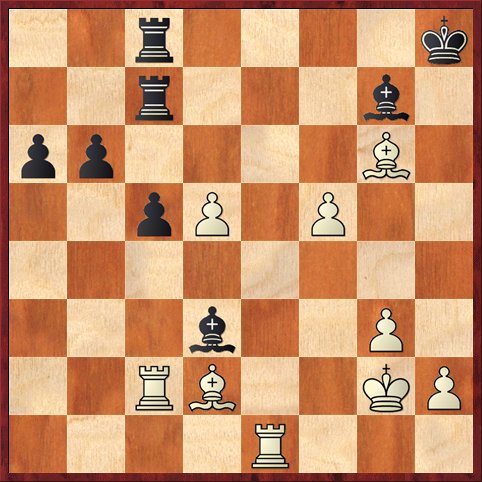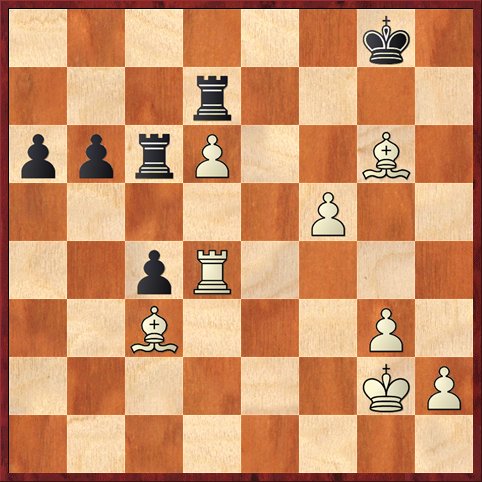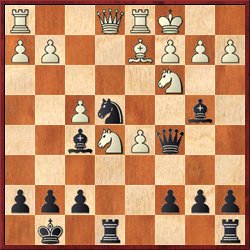Day two of the Chicago Open went a lot better for me than the first day. I felt as if I played good, creative, and very substantive games. I won the first one against a class A player named Bora Yagiz, and lost the second against a FIDE Master, Adnan Kobas. Really the only thing I did wrong (both games) was get into time trouble. The game against Kobas was especially intense. I squandered 59 minutes on my first 9 moves, and that kind of set the tone. By the time we got to move 25, I was down to something like 3 minutes for 15 moves — really horrific time pressure. I played the last four moves of the time control with 1 second left on my clock! (This was possible because we were playing with a 5-second time delay.) I made it to move 40 somehow, but by then my position was shot. 🙁
But it’s impossible to be too sad, because I’m having so much fun. What a great tournament for spectating! With 23 GM’s in the field, we have more grandmasters than the U.S. Championship did! (Only 21 of the 24 players in the U.S. Championship were grandmasters.) After three rounds there are six players with 3-0 scores: Najer, Akobian, Stocak, Sedlak, Khachiyan, and Gareyev. Those aren’t exactly the big names, but the people you have heard of — such as Michael Adams of England and Loek van Wely of the Netherlands — have already been nicked for draws.
Another treat yesterday was eating dinner with Andres Hortillosa. His new enterprise, SmartChess, is demo-ing its product at this tournament, with roll-out planned for the World Open or the U.S. Open later this summer. Sorry I can’t tell you more because I think I’nm still under the non-disclosure agreement. Andy is playing in the under-2100 section.
For people who like chess positions, here are some positions from my games today.
The Two Monsters
Technically they’re called the “two bishops,” but I think that “two monsters” is a better name for them in this game.
In the second around I got to this position after the time control, with White to play his 42nd move. At the time I had no idea whether I was winning or losing. It’s a little bit hard to get your bearings with seven passed pawns (!) on the board. I don’t think I have ever been in a position with so many passed pawns.
However, in hindsight I think I can explain pretty well what is going on. First of all, you don’t really have to pay attention to all of those pawns. What really matters is the ones that are farthest advanced: White’s d5 and f5 pawns, and Black’s c5 pawn. Very quickly we see that White not only has more pawns, but also his pawns are farther advanced. This gives us reason to be optimistic about White’s chances. However, the optimism is tempered by the fact that the f-pawn is currently pinned and the d-pawn is very weak.
Now let’s look at the pieces. Again, we can be optimistic because White controls the only open file on the board. However, the bishops on both sides are monsters — really more effective than the rooks. If White could get rid of one of those bishops, then he would be the only one left with the Two Monsters.
So that suggested the move I played, which I think is winning by force: 42. Rc3! Please, go ahead and take my rook! If 42. … Bxc3 43. Bxc3+ Kg8 44. Re3! c4 45. g4! and Black has no good answer to the plan of Rh3 and Rh8 mate. By the way, I did not yet see this rook-lift theme, so I didn’t realize I was winning. I played the exchange sac more out of general considerations, as the only reasonable way to play for a win.
My opponent played 42. … c4 and I continued 43. Re3! Now 43. … Bxc3+ would transpose into the previous line. But now Black has a huge problem. I am threatening d6 next move, and suddenly the previously weak d-pawn turns into a monster, too! As soon as one of his rooks leaves the c-file, I will snatch his bishop on d3, exploiting the pin on the c-file.
I don’t think there is anything Black can do here. He played 43. … Bf6, and I carried out the aforementioned threat: 44. d6 Rd7 45. Rexd3 Bxc3 46. Bxc3+ Kg8 47. Rd4 (Believe it or not, this is the first time when I actually spotted the idea of the rook lift to the h-file and checkmate on h8. I think my opponent still didn’t see it.) 47. … Rc6 and now …
White to play and win. (You know the answer already, if you’ve been reading.)
48. Rh4! and White wins. Verily, the triumph of the Two Monsters! The only way for Black to defend mate is 48. … Rg7, but then after 49. Bxg7 Kxg7 50. d7 it’s completely easy.
Delusions of Grandeur
In the third round, I sacrificed a pawn in the opening and got very good compensation. We arrived at the following position:
Quiz: How does Black finish White off if he plays 15. Na4?
To be honest, I thought I was just winning here. Black has the immediate threat of … Nf2, winning the exchange, and he also has some not-so-secret ambitions relating the the square c2. That’s a clue to the quiz question.
Have you figured it out?
Okay, what I saw at the board was that if White plays 15. Na4 Black can sacrifice the queen with 15. … Qxc2+!! 16. Kxc2 Nc5+! 17. Kc1 Nd3+. We arrive at a position that is reminiscent of the famous “mill” combination from the game Carlos Torre – Emmanuel Lasker. If White runs for the corner with 18. Kb1 Nxe1+ 19. Ka1, he is dragged back out with 19. … Nc2+, and we get a repeated discovered check theme just like in the mill. Perhaps we can call this the “junior mill” because it is executed with a smaller piece, or for a more vivid name we can call it the “mortar and pestle.” Instead White needs to play 18. Kc2 Nxe1+ 19. Kb3, but Black is still going to come out on top after 19. … Bxd2.
But, going back to the actual game, a funny thing happened. I was so caught up in my delusions of grandeur that I completely forgot to analyze the move that White played, which is obviously better: 15. Ne5!
What does Black do now?
The first thing to notice is that 15. … Nf2 doesn’t work because of 16. Be3. Not only that, 15. … Bxc3 16. Bxc3 Nf2 doesn’t work because of 17. b4!, which chases Black’s queen away from the c-file and thus makes it possible for Black to play 18. Bd4 next move.
I didn’t see anything better than trading down into an endgame with 15. … Nxc3 16. Bxc3 Bxc3 17. Qxc3 Qxc3 18. bc. Time trouble was already starting to affect my judgement; I figured that the simplified position would be easy to play, and I also thought I would still be able to draw this position easily. In particular, White’s d-pawn looked very shaky. However, I was wrong on both points. Black has to be careful, and in fact it’s a mistake to try to win the d-pawn with 18. … f6 19. Nc4 Re2 20. Rd2 Rxd2? (which is what I played). He continued 21. Kxd2! Rd8 22. Ne3 Be4? 23. c4 c6 24. Kc3! and now the awful truth becomes clear: after 24. … cd 25. Kd4! I’m not winning nothin’. Here was where the time scramble began in earnest: I had only about 3 minutes left for my remaining 15 moves. But even with all the time in the world I wouldn’t have been able to save this position.
So what should I have played in the last diagrammed position? Actually, I started out the right way. 15. … Nxc3 16. Bxc3 was correct. But then I needed to play the simple 16. … f6! The first key point is that he cannot take my bishop on b4 because I checkmate him on c2. His only hope is 17. g4, to chase the bishop away from f5 so that he can take on b4. But now I can trade on c3 much more advantageously than before: 17. … Bxc3 18. Qxc3 Qxc3 19. bc Bc8! (A cute maneuver, reminiscent of the Fritz Variation of the Two Knights Defense) After he moves his knight away, I take his pawn on g4. Black may not be absolutely winning yet, but with the material back to even, a bishop against knight, and with White’s pawn formation a complete mess, Black is definitely better.
Oh, well. “Simple chess,” Jesse Kraai always says. What could be simpler than attacking a pinned knight with 16. … f6? The problem with chess is that finding the simple moves is sometimes so complicated!







{ 1 comment… read it below or add one }
Hi Dana,
Go ahead and break the news (even some details) to your readers about what we are doing (and intend to do) with our chess app called SmartChess for iPhone, iPad, and iPod Touch.
Andres